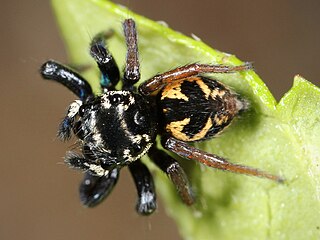
Phidippus is a genus in the family Salticidae. Some of the largest jumping spiders inhabit this genus, and many species are characterized by their brilliant, iridescent green chelicerae. Phidippus is distributed almost exclusively in North America, with the exception of two exported species. As of January 2021, there were about 80 described species in the genus. Species previously described in Phidippus which are found in India and Bangladesh do not belong in this genus.

Habronattus is a genus in the family Salticidae. Most species are native to North America. They are commonly referred to as paradise spiders due to their colorful courtship ornaments and complex dances, similar to birds-of-paradise.
Ashtabula is a genus of jumping spiders that was first described by G. W. Peckham & E. G. Peckham in 1894.

Balmaceda is a genus of jumping spiders that was first described by George Peckham & Elizabeth Peckham in 1894.

Beata is a genus of jumping spiders that was first described by George Peckham & Elizabeth Peckham in 1895.

Chapoda is a genus of jumping spiders that was first described by George Peckham & Elizabeth Peckham in 1896.

Corythalia is a genus of jumping spiders that was first described by Carl Ludwig Koch in 1850.

Lyssomanes is a spider genus of the family Salticidae, ranging from South and Central America, up to the southern United States.

Metacyrba is a genus of jumping spiders that was first described by Frederick Octavius Pickard-Cambridge in 1901. The name is combined from Ancient Greek μετά "after, beside" and the salticid genus Cyrba.

Metaphidippus is a genus of jumping spiders that was first described by Frederick Octavius Pickard-Cambridge in 1901. The name is combined from Ancient Greek μετά "after, beside" and the salticid genus Phidippus.

Pachomius is a genus of jumping spiders that was first described by George and Elizabeth Peckham in 1896. Uspachia was merged into genus Romitia in 2007, and all nine species were merged into Pachomius in 2015. The name is derived from Pachomius, the founder of cenobitic monasticism.

Paramarpissa is a genus of North American jumping spiders that was first described by Frederick Octavius Pickard-Cambridge in 1901. Originally considered a synonym of Pseudicius, it was separated into its own genus in 1999.

Paraphidippus is a genus of jumping spiders that was first described by Frederick Octavius Pickard-Cambridge in 1901. The name is a combination of the Ancient Greek "para" (παρά), meaning "alongside", and the salticid genus Phidippus.

Phanias is a genus of jumping spiders that was first described by Frederick Octavius Pickard-Cambridge in 1901. They are similar to members of Marpissa, but have three pairs of spines beneath the first tibia.

Sassacus is a genus of jumping spiders that was first described by George and Elizabeth Peckham in 1895. It is likely named after Sassacus, a Native American chief of the 16th and 17th century.
Sidusa is a genus of jumping spiders that was first described by George and Elizabeth Peckham in 1895.

Euophryini is a tribe of jumping spiders. It has also been treated as the subfamily Euophryinae.
Metaphidippus pernix is a species of spider in the Salticidae family found in Guatemala.

Habronattus mexicanus is a jumping spider species in the genus Habronattus. It is the type species of that genus.
















